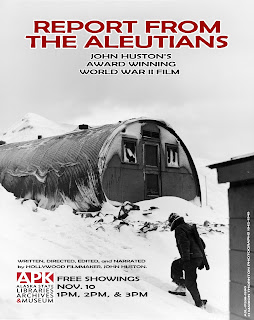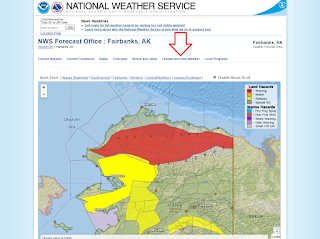Summer is just around the corner, and if you're anything like me, you're dreaming about your summer travel plans! If Juneau is one of your of stops this summer, a visit to the new Father Andrew P. Kashevaroff State Library, Archives, and Museum should be on your to-do list.
How to get here:
The APK is located at 395 Whittier Street, a short walk from the cruise ship docks or an easy drive from the airport or ferry terminal. If you're coming from the docks furthest south, it's a straight shot along the waterfront. Thane Road becomes South Franklin Street, then Marine Way, then Egan Drive. You'll travel past City Hall, the blue Wharf building and the float plane hangar, Centennial Hall, and the Juneau Arts and Culture Center. Turn right at the traffic light onto Whittier Street and you'll see the Nimbus sculpture in our front plaza.
 |
| This is the view of the APK State Library, Archives, and Museum that you'll see when you turn onto Whittier from Egan Drive. Photo by Lara Swimmer. |
If you're coming from the airport, ferry terminal, or other points north, head south on Egan Drive towards downtown. There's only one highway in Juneau, so it's hard to miss. After you pass the Douglas Bridge, then take a left at the traffic light onto Whittier Street. The APK will be on your left, just past the KTOO radio station.
Where to park:
If you're in your own car, you can park in our underground parking garage off Whittier. One local called it the nicest garage in town, and visitors can park there for up to three hours while in the building. The gates go down when the building closes, but you'll still be able to get out if you're in the building. If you've left the facility and the building is closed, your car will be waiting for you when the gates open in the morning.
 |
| Our parking garage is well-lit and provides easy access to the APK facility. The public entrance with stairs and elevator is in the far corner of this photo. |
What's here:
You'll find the
Alaska State Library on the second floor. There's free wi-fi and public
computers to check your email or share photos on social media, and
newspapers like the New York Times and periodicals like The Economist,
Wired, or Time to help you get your news fix. If you want to do
genealogy research or look at historic photos, you can visit the
Historical Collections and Archives Research Center.
 |
| Patrons in the Alaska State Library's Richard Foster Reading Room. It's a great place to relax, research, or keep in touch with folks back home. Photo by Lara Swimmer. |
The Alaska State Museum's permanent exhibits were fully re-designed over the past four years and present a wide-angle view of the state's history, including Alaska Native cultures, the periods as a Russian colony and an American territory, and post-statehood. There are also displays about industry in Alaska, shipwrecks, World War II, a children's Discovery Room, and three temporary galleries with rotating exhibits. Find more info on
the Alaska State Museum's web site.
The APK is home to Raven Cafe, run by the fantastic folks who operated
Twilight Cafe over by the State Office Building. Their
specialties include enormous adobo burritos, breakfast sandwiches, house
made soups, refreshing fruit smoothies, and coffee and espresso drinks
to keep you going. This summer, local literary maven Katrina Woolford
will be running our gift store, which will have art, books,
and other gifts for everyone at home. She plans to open for business by
June 1.
 |
| Raven
Cafe is a popular spot for visitors, locals, and staff to grab coffee
or lunch. The Cristobals are always cooking up new creations so their
menu is never the same. Photo by Lara Swimmer. |
When to come:
Summer hours begin in mid-May. The Alaska State Library, Historical Collections, and Archives are open Tuesdays through Fridays from 10:00 am to 4:00 pm and Mondays for research appointments. The Alaska State Museum will have transitional hours in early May, and 9:00 am-5:00 pm daily from mid-May through mid-September. Call (907) 465-2901 for the early May schedule.
Winter hours for the Alaska State Library, Historical Collections, and Archives are Tuesdays through Fridays from 10:00 am to 4:00 pm. Winter hours for the Alaska State Museum are Tuesdays through Saturdays, 10:00 am to 4:00 pm.
Hope to see you here at the APK this summer!























































